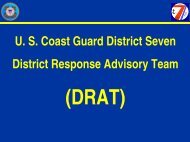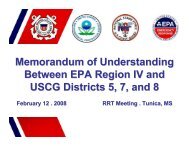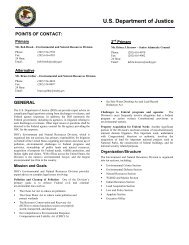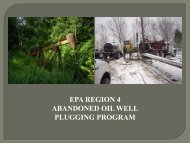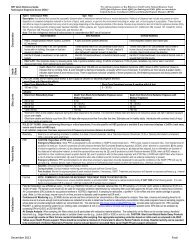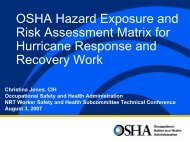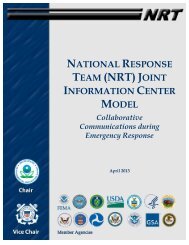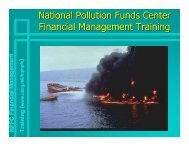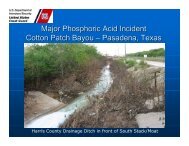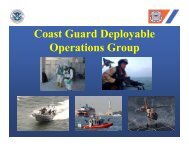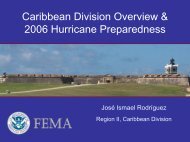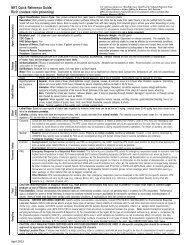USE OF DISPERSANTS - U.S. National Response Team (NRT)
USE OF DISPERSANTS - U.S. National Response Team (NRT)
USE OF DISPERSANTS - U.S. National Response Team (NRT)
- No tags were found...
Create successful ePaper yourself
Turn your PDF publications into a flip-book with our unique Google optimized e-Paper software.
the shallower, nearshore waters where dispersant application is not pre-authorized. Many of the sea turtles andcetaceans that occur more frequently in the open waters of the pre-authorized area are present there seasonally,reducing the risk they would be affected. Potential effects of dispersant use on listed species that may occur in thearea under consideration for pre-authorization by the Letters of Agreement are considered below.Direct Contact and IngestionBy removing the surface oil slick, dispersants reduce the risk of direct contact with wildlife that dwell at or passthrough the water surface to feed or breath such as sea birds, sea turtles, and cetaceans. Juvenile sea turtles, whichoften are found with drifting sargassum mats in convergence areas further from shore, would particularly benefitfrom removal reduced surface exposure in the area under consideration. Sea turtles and cetaceans may experiencehigher exposure in the water column, primarily in the upper few meters, following dispersion. In open waters withcontinuous mixing and dilution capabilities, however, dispersed oil is rapidly diluted. Considering thatconcentrations fall to background levels within the first few hours following dispersion, exposure will be short-termand at low concentrations. Most marine mammals do not drink large volumes of sea water and so probably will notingest significant quantities of oil directly from solution or dispersion in the water column (Neff, 1990). Exposure ofsea turtles to tar balls, which they are known to ingest and which also adhere to juveniles, would be reduced becausedispersants help prevent tarball formation. Dispersed oil droplets are less sticky and therefore less likely to adhere tobaleen plates, skin, feathers, or other body surfaces than undispersed or naturally dispersed oil (Neff, 1990).According to the Letters of Agreement, dispersants will not be sprayed near listed species or other wildlife. Dataindicate that dispersant alone is unlikely to contribute significantly to adverse biological effects in the water column.Within the normal range of operating dosages, biological effects are due to the dispersed oil, not the dispersant(NRC, 1989; SEA, 1995).Prey ContaminationIf zooplankton, fish, and other water column or benthic organisms become oiled or accumulate oil in their tissues,they could ultimately expose species that prey upon them. Marine mammals, except the manatee, are carnivores thatrely on invertebrates or fish for sustenance. Several sea turtle species that occur in the area under consideration foraction also prey on aquatic invertebrates and fish. Prey species that occur in open waters further from shore wheredispersant use will be pre-authorized are the primary concern. Those that occur in nearshore areas where dispersantuse will not be pre-authorized by the Letters of Agreement are unlikely to be impacted.Most aquatic organisms have the ability to metabolize and depurate petroleum hydrocarbons. Existing datademonstrate that complete depuration occurs once the source of the contamination is removed. It is unlikely thatsignificant amounts of petroleum hydrocarbons will be accumulated by pelagic organisms during a dispersantapplication because of the short duration and low concentration expected in the water column. Under suchconditions, any accumulated petroleum hydrocarbons should be rapidly depurated. Marine food chainbiomagnification does not occur because vertebrate predators readily metabolize and depurate hydrocarbons fromtheir tissues. Most marine organisms also metabolize and excrete the surfactants in dispersants. Metabolism ofsurfactants is rapid enough that there is little likelihood of food chain transfer from marine invertebrates and fish topredators, including the listed sea turtles and cetaceans (Neff, 1990).Marine finfish, for example, take up petroleum hydrocarbons from water and food. The compounds induce thehepatic Mixed-Function-Oxidase (MFO) system and within a few days following exposure, aromatic hydrocarbonsare oxygenated to polar metabolites and excreted. For this reason, most fish do not accumulate and retain highconcentrations of petroleum hydrocarbons and so are unlikely to transfer them to predators, such as the listed seaturtles and cetaceans. The fish may be tainted with metabolites bound to tissue macromolecules, but thesemetabolites are so reactive that it is unlikely that they would be released in a toxic form during digestion by theconsumer and so would not pose a serious risk (Neff, 1990).Zooplankton, which are a particularly important food source for baleen whales, can become contaminated byassimilating hydrocarbons directly from seawater and by ingesting oil droplets and tainted food. Planktoniccrustaceans can transform aromatic hydrocarbons to polar metabolites that may be excreted or bound to tissues. For



